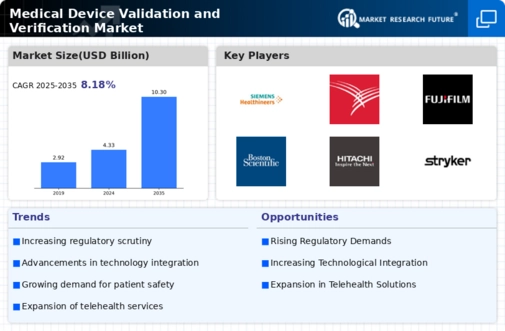The Global Medical Device Validation and Verification Market is characterized by rapid advancements in technology and stringent regulatory standards aimed at ensuring device safety and effectiveness. This dynamic market is witnessing escalating competition due to the rising number of medical device manufacturers and the increasing complexity of devices being developed. As companies aim to meet rigorous regulatory requirements, the emphasis on validation and verification processes becomes paramount, creating abundant opportunities for specialized service providers.
The landscape is further influenced by the growing necessity for successful clinical trials and post-market surveillance, which serve as essential components in assuring the quality of medical devices. This highly fragmented market sees a variety of players uniquely positioned to cater to diverse segments ranging from software validation to hardware testing.
Siemens Healthineers has established itself as a formidable player in the Global Medical Device Validation and Verification Market, showcasing a strong commitment to innovation and quality. The company's robust portfolio of advanced imaging and laboratory diagnostics technologies empowers it not only to deliver high-quality medical devices but also to ensure thorough validation and verification processes. Siemens Healthineers leverages state-of-the-art methodologies to comply with regulatory standards, thereby enhancing its credibility among healthcare providers. Furthermore, the company's extensive experience in clinical settings allows it to offer valuable insights into device performance and approval pathways.
A strong focus on collaboration and strategic partnerships enables Siemens Healthineers to expand its market presence and tailor solutions that meet specific customer needs while maintaining compliance with established guidelines.GE Healthcare also plays a significant role in the Global Medical Device Validation and Verification Market, showcasing its strength in delivering innovative healthcare solutions. The company is known for its advanced imaging systems and analytics, which are instrumental in facilitating accurate diagnostics and treatment.
GE Healthcare emphasizes a rigorous approach to validation and verification, ensuring that its devices not only adhere to regulatory standards but also meet the expectations of healthcare professionals. The organization benefits from a rich history of technological advancements, granting it depth of knowledge in the validation process. Additionally, partnerships with regulatory bodies and compliance experts allow GE Healthcare to stay ahead in the fast-evolving landscape of medical devices, confirming its commitment to high-quality standards and reliable performance in patient care.
The company's strategic initiatives further solidify its position in the market, making it a key player in validating and verifying medical devices essential for modern healthcare.






















Leave a Comment